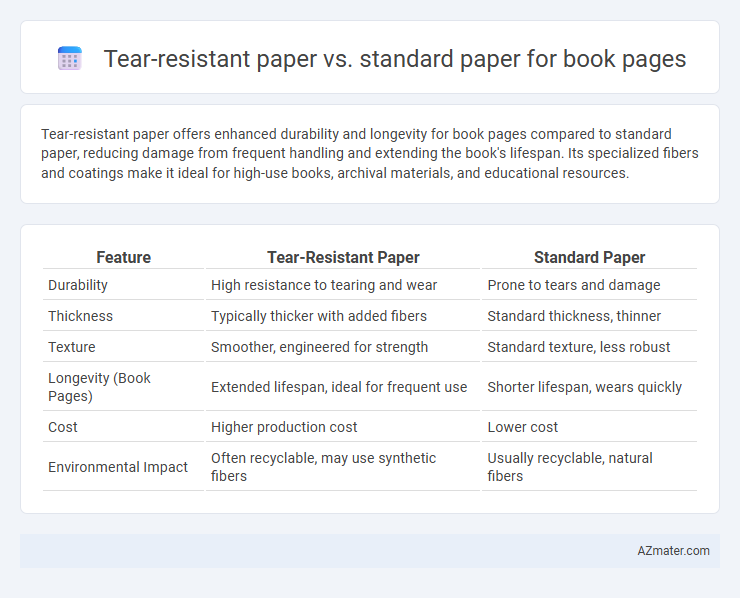Tear-resistant paper offers enhanced durability and longevity for book pages compared to standard paper, reducing damage from frequent handling and extending the book's lifespan. Its specialized fibers and coatings make it ideal for high-use books, archival materials, and educational resources.
Table of Comparison
| Feature | Tear-Resistant Paper | Standard Paper |
|---|---|---|
| Durability | High resistance to tearing and wear | Prone to tears and damage |
| Thickness | Typically thicker with added fibers | Standard thickness, thinner |
| Texture | Smoother, engineered for strength | Standard texture, less robust |
| Longevity (Book Pages) | Extended lifespan, ideal for frequent use | Shorter lifespan, wears quickly |
| Cost | Higher production cost | Lower cost |
| Environmental Impact | Often recyclable, may use synthetic fibers | Usually recyclable, natural fibers |
Introduction to Tear-Resistant Paper and Standard Paper
Tear-resistant paper, engineered with synthetic fibers and advanced coatings, offers enhanced durability and longevity compared to standard paper, which is primarily made from wood pulp fibers. This specialized paper resists ripping, making it ideal for frequently handled book pages and archival materials. Standard paper tends to degrade faster under stress and environmental factors, leading to increased wear and tear over time.
Composition and Manufacturing Differences
Tear-resistant paper for book pages is typically composed of synthetic fibers like polyester or a blend of wood pulp with reinforcing agents that enhance durability and flexibility, whereas standard paper primarily consists of cellulose fibers derived from wood pulp alone. Manufacturing tear-resistant paper involves specialized processes such as refining fiber blends, adding cross-linking polymers, and applying chemical treatments to increase tensile strength and reduce brittleness, in contrast to standard papermaking techniques focused on cost-effective pulp processing and drying. These differences result in tear-resistant paper offering superior resistance to physical damage and longer lifespan compared to conventional paper used in book pages.
Durability and Longevity Comparison
Tear-resistant paper significantly outperforms standard paper in durability, featuring enhanced fiber bonding and synthetic reinforcements that resist ripping and tearing under stress. This durability translates to greater longevity for book pages, maintaining structural integrity even with frequent handling or environmental exposure such as moisture and UV light. Standard paper, typically made from shorter fibers and lacking protective coatings, deteriorates faster, leading to frayed edges, brittleness, and eventual page loss.
Resistance to Environmental Factors
Tear-resistant paper offers superior durability against environmental factors such as moisture, temperature fluctuations, and UV exposure compared to standard paper, significantly reducing the risk of tearing and deterioration over time. Its reinforced fiber structure and special coatings enhance resistance to humidity and fading, making it ideal for books frequently handled or stored in less controlled environments. Standard paper, lacking these protective features, tends to weaken and yellow faster, compromising the longevity and readability of book pages under adverse conditions.
Print Quality and Visual Appeal
Tear-resistant paper for book pages offers superior durability without compromising print quality, ensuring vibrant ink retention and sharp text clarity. Compared to standard paper, it resists smudging and fading, maintaining a professional and polished visual appeal over time. The textured surface of tear-resistant paper enhances color depth and contrast, resulting in a more visually engaging reading experience.
Cost Analysis: Tear-Resistant vs Standard Paper
Tear-resistant paper for book pages typically costs 20-40% more than standard paper due to its specialized fiber composition and manufacturing process designed to enhance durability. While the initial investment is higher, tear-resistant paper reduces replacement and repair expenses over time, benefiting high-usage or archival publications. Standard paper offers lower upfront costs but may lead to increased long-term maintenance and replacement costs, especially in frequent-handling environments.
Eco-Friendliness and Sustainability
Tear-resistant paper for book pages typically uses advanced polymer blends or reinforced fibers, which can increase durability but may complicate recycling processes compared to standard paper made from 100% recycled or sustainably sourced fibers. Standard paper generally has a lower environmental impact, as it is more biodegradable and easier to recycle, contributing to reduced waste and resource consumption. Choosing tear-resistant paper can extend the lifespan of a book, potentially reducing the frequency of replacements, but its synthetic components may pose challenges for circular economy practices in paper recycling.
Application in Book Publishing
Tear-resistant paper enhances durability in book publishing by preventing page damage during frequent handling, making it ideal for textbooks, children's books, and reference materials. Standard paper, commonly used for novels and general reading materials, offers cost-effective production but lacks the strength needed for high-traffic usage. Publishers prioritize tear-resistant paper for long-lasting editions to reduce replacement costs and improve reader satisfaction.
User and Reader Experience
Tear-resistant paper enhances book durability, providing readers with a smoother, more resilient surface that withstands frequent handling without damage. Standard paper often feels thinner and more fragile, increasing the likelihood of tears and wear, which can disrupt the reading process and reduce the book's lifespan. For users seeking long-lasting books, tear-resistant paper ensures a superior tactile experience and maintains page integrity over time.
Choosing the Right Paper for Your Book
Tear-resistant paper offers enhanced durability and longevity, making it ideal for books subjected to frequent handling or environmental stress, compared to standard paper's vulnerability to wear and damage. Its stronger fibers and reinforced composition reduce the risk of page tears, preserving the book's quality over time. Selecting tear-resistant paper increases reader satisfaction and maintains the book's integrity, especially for children's books, reference materials, and frequently used publications.

Infographic: Tear-resistant paper vs Standard paper for Book page
 azmater.com
azmater.com